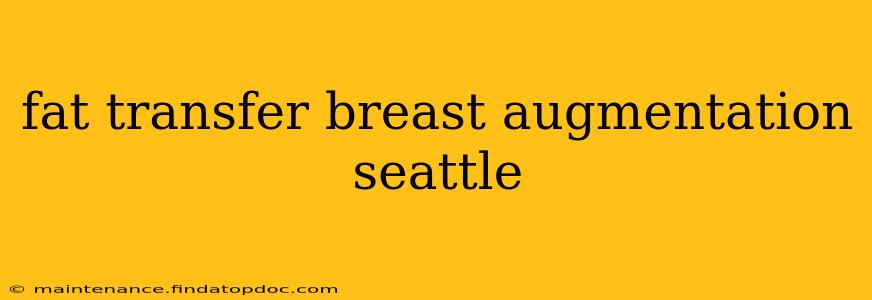Seattle offers a range of cosmetic surgery options, and fat transfer breast augmentation is becoming increasingly popular. This procedure, also known as autologous fat grafting, uses your own body fat to enhance breast size and shape. This guide will explore the procedure, its benefits and drawbacks, what to expect during and after surgery, and answer frequently asked questions.
What is Fat Transfer Breast Augmentation?
Fat transfer breast augmentation is a minimally invasive procedure that involves harvesting fat from one area of your body (typically the abdomen, thighs, or hips) and transferring it to your breasts. A liposuction technique is used to extract the fat, which is then processed to remove impurities before being carefully injected into the breasts using specialized cannulas. This results in a more natural-looking breast augmentation compared to traditional implant surgery.
What are the Benefits of Fat Transfer Breast Augmentation?
- Natural Results: Because the augmentation uses your own tissue, the results appear more natural and integrated than with implants. The breasts feel softer and more natural to the touch.
- Breast Enhancement and Reshaping: Fat transfer can not only increase breast size but also improve breast shape, address asymmetry, and correct volume loss due to aging or weight fluctuations.
- Minimally Invasive: Compared to implant surgery, fat transfer is considered less invasive, often resulting in less scarring and a shorter recovery time.
- Improved Body Contouring: The liposuction component of the procedure can simultaneously improve the contours of other body areas, providing a two-for-one benefit.
What are the Drawbacks of Fat Transfer Breast Augmentation?
- Fat Absorption: A percentage of the transferred fat is typically absorbed by the body. Multiple procedures may be necessary to achieve the desired results.
- Not Suitable for Large Augmentations: Fat transfer is not ideal for individuals seeking a significant increase in breast size. Smaller augmentations or enhancements are more successfully achieved with this technique.
- Potential for Complications: As with any surgical procedure, there are potential risks such as infection, hematoma (blood clots), and irregularities in the breast shape.
- Cost: Fat transfer can be more expensive than traditional implant surgery due to the complexity of the procedure and the need for multiple sessions in some cases.
How is Fat Transfer Breast Augmentation Performed?
The procedure typically involves three steps:
- Liposuction: Fat is extracted from a donor site using liposuction techniques.
- Fat Processing: The harvested fat is processed to separate fat cells from other tissue components.
- Fat Injection: The purified fat is carefully injected into the breasts using specialized cannulas. The surgeon meticulously places the fat to achieve the desired breast shape and volume.
What is the Recovery Process Like?
Recovery from fat transfer breast augmentation varies depending on the individual and the extent of the procedure. Expect some bruising, swelling, and discomfort in both the donor and recipient sites. Compression garments are typically worn for several weeks to minimize swelling and support healing. Most patients can return to their normal activities within a few days or weeks, but strenuous activity should be avoided for several weeks.
How Much Does Fat Transfer Breast Augmentation Cost in Seattle?
The cost of fat transfer breast augmentation in Seattle varies depending on the surgeon's experience, the extent of the procedure, and the facility. It's essential to consult with several surgeons to obtain accurate pricing information and compare their services.
What are the Long-Term Results of Fat Transfer Breast Augmentation?
The longevity of results depends on various factors, including individual metabolism, lifestyle, and the amount of fat absorption. While some fat absorption is expected, a significant portion of the transferred fat typically remains, resulting in long-lasting breast enhancement. However, significant weight fluctuations can affect the final results.
Does Insurance Cover Fat Transfer Breast Augmentation?
Insurance typically does not cover cosmetic procedures such as fat transfer breast augmentation. However, it is advisable to discuss coverage options with your insurance provider.
Who is a Good Candidate for Fat Transfer Breast Augmentation?
Ideal candidates are generally healthy individuals with sufficient body fat to harvest and who desire a moderate increase in breast size or improvement in breast shape. It is crucial to have realistic expectations and discuss your goals with a qualified plastic surgeon to determine your suitability for the procedure.
Remember to consult a board-certified plastic surgeon in Seattle for a personalized consultation to determine if fat transfer breast augmentation is the right option for you. They can thoroughly assess your needs, address your concerns, and help you make an informed decision.
